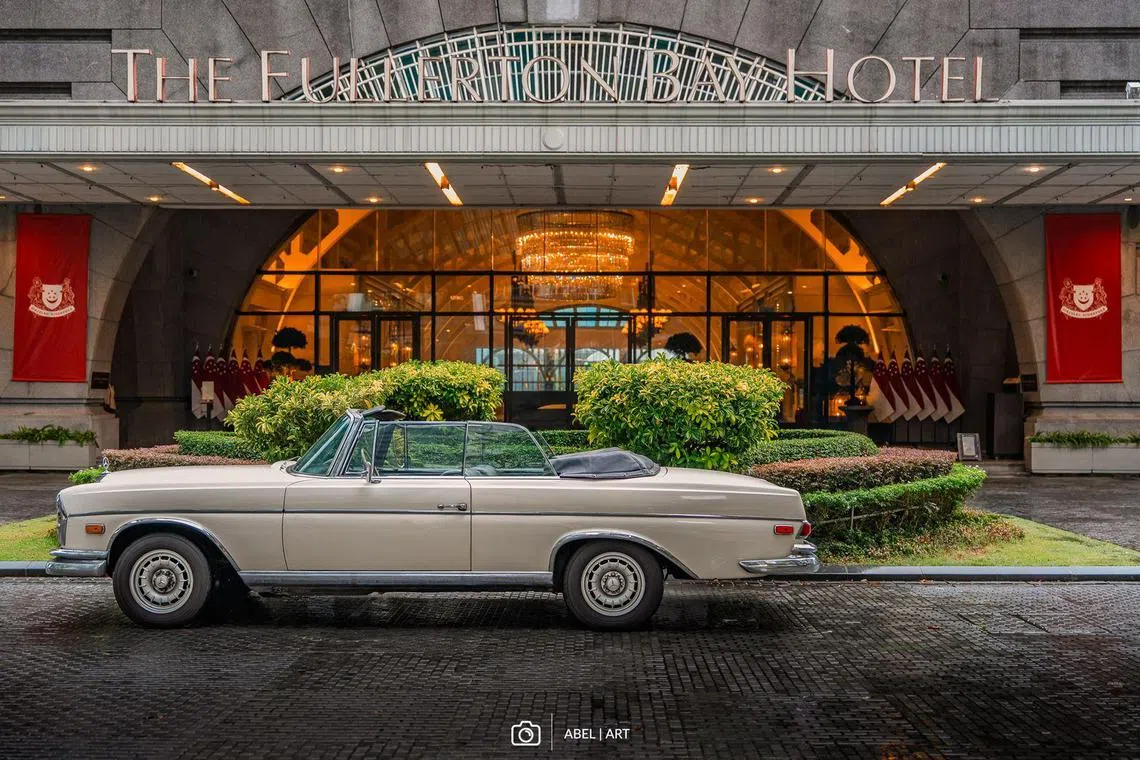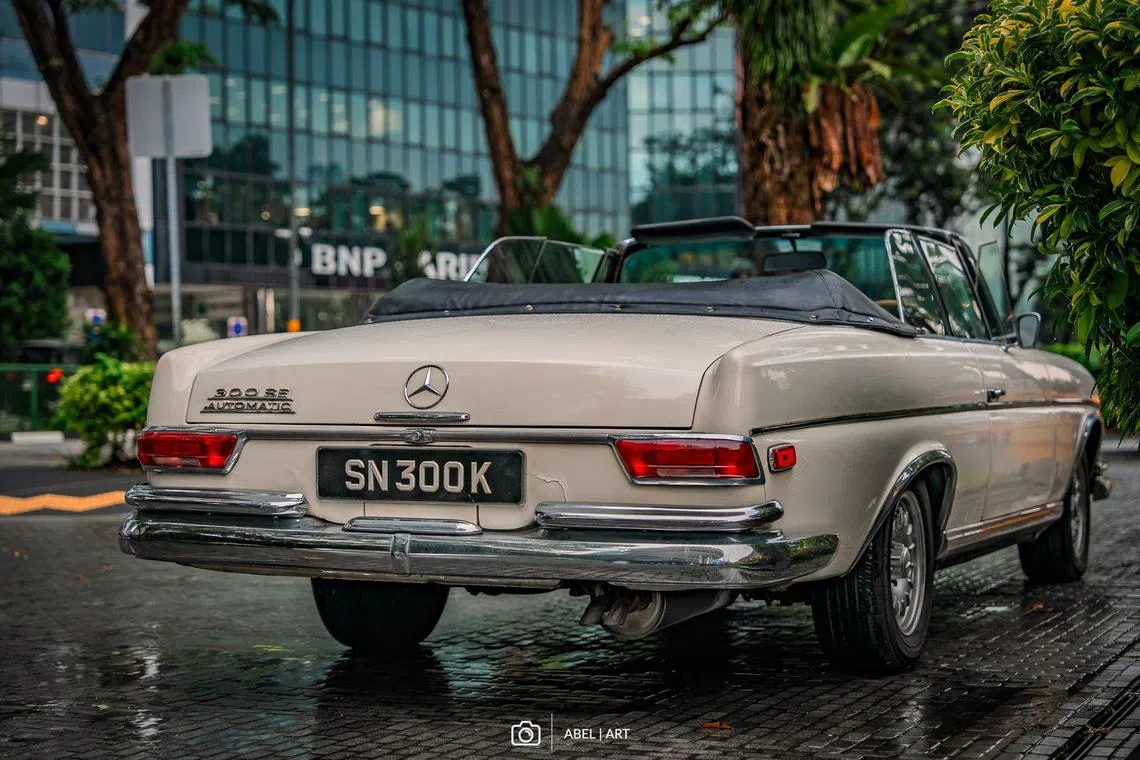A journey through time with a car as old as Singapore
Contemplating Singapore’s car journey through the years with a 1965 Mercedes Benz 300SE Cabriolet
A PIER and a car. Both steeped in the history of Singapore, embedded within conversations about transport and conveyance, albeit in relation to different elements.
Clifford Pier, an elegant old lady with graceful arches, shedding its “ang teng” or red lantern past so effectively and completely. The transit point for sailors and passengers on ships and ferries, with the view towards Batam in the 1960s unobstructed by the Marina Bay Sands integrated resort today.
The 1965 Mercedes Benz 300SE Cabriolet, having an altogether different genesis, beginning and continuing life at the apex of automobilia. It won’t be difficult imagining Audrey Hepburn driving this at the height of her fame, and the car continues to look fabulous at 60 years of age.
This car cost approximately S$60,000 back then, and if adjusted for inflation would now cost around S$274,000 in 2024 – without the Additional Registration Fee (ARF) and the Certificate of Entitlement (COE).
This car would have been imported from what was West Germany, as the Mercedes-Benz factory in Singapore at Hillview only produced the basic W108 280S.
Both transitioned through the turbulent 1960s, but the 300SE’s largely uneventful early life became far more complicated in the 1970s with traffic congestion and gridlock. In contrast, the total vehicle population was just 192,422 in December 1965, compared to 1,009,499 in June 2025.

The times they are a’ changing
Kumar Balasingam – the owner of the Cabriolet and the current president of the Classic Car Club of Singapore – said that when the Area Licensing Scheme (ALS) began in 1975, vehicles with more than four people could enter the Central Business District (CBD) for free.
ALS was Singapore’s first attempt at vehicle congestion control, where vehicle owners paid a fee to enter the CBD.
He fondly remembers picking up some entrepreneurial boys, who waited just before the gantry to jump in the car and then jump out again just after, getting a small tip in the process. They would repeat the entire process over again, all under the watchful eyes of the policemen stationed there. Life was much simpler then.
SEE ALSO
Singapore’s Traffic Concept Plan, which the government commissioned in 1967, saw the advent of expressways in the 1980s, with the Pan-Island Expressway (PIE) being the first.
Kumar, who got his licence in 1975, remembers the fast sweeping bends on the PIE, exactly what big Mercedes-Benzes were designed for.
Being developed for the Autobahn, the local expressway experience would be scenic, seamless and coherent, but substantially less challenging to drive, especially through the green catchment areas in the middle of Singapore.
However, such speeds in the 300SE with the top down were inadvisable as wind deflectors were not available then for the car, and wind buffeting in the cabin would have been extreme.
The ALS was merely the precursor to the overall policy application in the 1970s and 1980s, and Singapore was then held out as a beacon for urban traffic management.
In 1975, the ARF was increased to a 100 per cent of the open market value of the car, up from 15 per cent in 1968. And the COE quota system was launched in May 1990, with ALS being replaced by the Electronic Road Pricing (ERP) scheme in April 1998.
For cars more than 35 years old, there is the Classic Vehicle Scheme, where owners pay just 10 per cent of the prevailing quota premium for COEs, but these are limited to 45 days of usage per year.
Dollars and sense
Still, it is not cheap to buy, maintain and renew COEs even for a classic car in Singapore. So why would one even do this?
Kumar explained that in an era where the journey was as important as the destination, older, well-designed cars elevate the driving experience far more than any modern electric vehicle can. With a classic car, speed is not the only visceral element present.
The togetherness of an over-engineered car such as the 300SE, especially in navigating corners, the throttle, intake noise, exhaust burble, brakes and suspension all work together as one to overcome bumps and tightening curves, allowing the driver to experience the road in a fluid way, heightening the senses.
What more in a lovely cabriolet, which puts you intoxicatingly in the midst of your surroundings. Really immersive in an early morning drive down Old Upper Thomson Road, less so stuck in traffic in Orchard Road.

Kumar added that owners should view the ARF and COE costs as expense items, and not part of the intrinsic value of the car. This value, in most cases, appreciates over time, and it is not uncommon, with proper timing, to see a 20 to 50 per cent increase for certain machines.
This mindset currently exists in mature classic markets such as Europe, North America and Australia, especially with the appearance of managed funds there that allow enthusiasts and investors alike to share in the experience of owning a classic that appreciates over time.
Such cars are known as alternative luxury investments like wine, whisky, watches and art. This is a niche market, probably best represented by the Pebble Beach Concours d’Elegance car show in California.
All said and done, if one can afford a classic car, whether as a regular car or under the Classic Vehicle Scheme, the experience is worth the effort.
In fact, it’s hard to see the technology-heavy cars of today having a lifespan beyond two decades because of limited production of parts for their digital systems. Mechanical parts are easy to replace, but the same is not true of computer chips when they end production.
In contrast, this grand old dame will probably live to see SG70 in 2035 or even SG80, given its immaculate build and Mercedes-Benz’s continued support for its classics.
This story and the photo shoot were facilitated by The Fullerton Bay Hotel
Decoding Asia newsletter: your guide to navigating Asia in a new global order. Sign up here to get Decoding Asia newsletter. Delivered to your inbox. Free.
Copyright SPH Media. All rights reserved.






